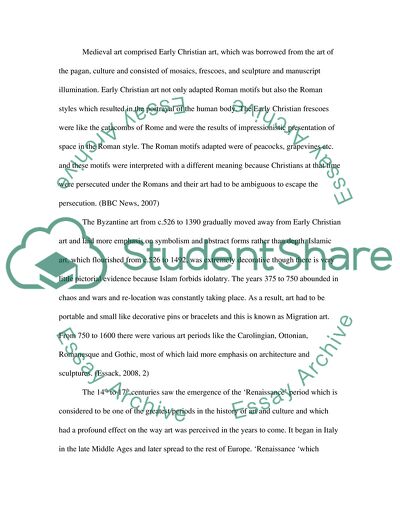
- Home
- Free Samples
- Premium Essays
- Editing Services
- Extra Tools
- Essay Writing Help
- About Us
- Studentshare
- Subjects
- Miscellaneous
- Art: Past-Present
Art: Past-Present - Essay Example

- Subject: Miscellaneous
- Type: Essay
- Level: Masters
- Pages: 4 (1000 words)
- Downloads: 0
- Author: reingermarquise
Extract of sample "Art: Past-Present"
The Aegean civilization introduced airy and open architecture, frescoes and marble statues. (Essak, 2008, 1) The Classical civilization comprised the Greeks, the Etruscans and then the Romans. Earlier, the Greeks adopted the humanistic approach in art and their painting, architecture and sculpture were highly elaborate and represented humankind. On the Italian peninsula, the 6th - 5th centuries B.C saw the rise of the Etruscans who produced highly stylized sculptures, which were ornamental and gave the impression of motion.
The Romans rose in prominence from 509B.C to 337A.D and initially they attacked both Greek and Etruscan art. But, later they adapted from these cultures and created their own style which symbolized ‘power’. The sculptures of Gods, goddesses and important citizens were re-named, architecture became very elaborate and frescoes were huge affairs. Landscape painting took shape in a big way. (Essak, 2008, 1) Medieval art comprised Early Christian art, which was borrowed from the art of the pagan, culture and consisted of mosaics, frescoes, and sculpture and manuscript illumination.
Early Christian art not only adapted Roman motifs but also the Roman styles which resulted in the portrayal of the human body. The Early Christian frescoes were like the catacombs of Rome and were the results of impressionistic presentation of space in the Roman style. The Roman motifs adapted were of peacocks, grapevines etc. and these motifs were interpreted with a different meaning because Christians at that time were persecuted under the Romans and their art had to be ambiguous to escape the persecution.
(BBC News, 2007) The Byzantine art from c.526 to 1390 gradually moved away from Early Christian art and laid more emphasis on symbolism and abstract forms rather than depth. Islamic art, which flourished from c.526 to 1492, was extremely decorative
...Download file to see next pages Read MoreCHECK THESE SAMPLES OF Art: Past-Present
Summary and Critical Response
The Past, Present, and Future of Los Angeles
Future, past. present
Reflect on places and spaces that you are familiar with, whether in your past or in the present
The best presents are those that cost the least
Some of the best presents are those that cost the least
The Principles and Rules in the Present Companies Act 2006: Common Law and Case Law
Working at McDonalds by Amitai Etzioni

- TERMS & CONDITIONS
- PRIVACY POLICY
- COOKIES POLICY